Thank you all for your comments and support following my last post! You’ve given me a lot of ideas, and I really appreciate knowing that so many people are reading and being part of this community.
I’ve felt much perkier today, and mostly the fortnight isn’t too bad, and some things are really lovely.
Food has been one of the nice surprises. There are numerous recipes in NZ newspapers of the time, and daily menus given in lots of newspapers, so it was pretty easy to do my food research. I was a bit dubious about the menus (So much meat! So many brassicas! So few spices!), but, by picking ones that sounded a little more interesting and appealing, even within the constrains of the time, and winter food, I’ve actually been very pleasantly surprised.
One of the happiest finds was the amount of vegetarian menus and vegetarian recipes available in New Zealand newspapers of the 1910s. Vegetarianism was quite a popular fad, and was sometimes recommended for invalids. I haven’t relied too heavily on them, but have used them as a guide for substituting butter for lard etc. in recipes.
It’s also been nice to fully set the table, nicely pressed tablecloth and all, and sit down to eat with Mr D. Generally we just eat in the lounge (partly because I generally have the dining room table occupied by crafting stuff…)
Here is one dinner I made, closely based on this menu published in the Dominion (a Wellington newspaper) in September 1913. I used the curry recipe give in the menu, and sourced recipes for the other items from other newspaper articles:
Brown Onion Soup (halved). The recipe is from 1917, but closely matches ones from earlier cookbooks, I just chose to follow this one as it didn’t call for a dozen onions to start with!
My reaction: yum, yum! I love this and would happily eat it again!
Mr D’s reaction: you didn’t actually expect me to like this? (I knew he didn’t like raw onions, but he’s usually fine with cooked ones. He just wants them to not be THE flavour of a dish)
Curried Venison and Rice (substituting venison for mutton, and brown for white rice)
My reaction: better than I thought. Needs more spice. Not sure about the apples.
Mr D: It’s nice. A bit different. (I don’t make a lot of curries)
Boiled Swedes (rutabegas)
With salt and pepper.
Despite their oft-terrible reputation, we both liked them. Neither of us grew up with swedes, so they have novelty appeal. I actually make a swede recipe as part of my Thanksgiving table, much to the amusement of Mr D’s family, who do NOT see them as celebration food!
Also, they weren’t BEIGE! The one major problem with 1910s food is it is all beige!
Baked Apple Dumplings (another variation)
NZ had a major apple overload in the autumn/winter of 1916, because a shortage of available ships kept growers from exporting their crops. Cooks were urged to incorporate apples into as many dishes as possible (note the apples in the curry), and apples featured largely in many desserts. The pastry portion of this dessert would have been a bit of a luxury: the price of flour had gone up almost 1/3 since the war started.
I added sultanas (raisins) to my baked apple, as there are many baked apple dumpling recipes of the time that include them, and followed a period short-crust pastry recipe, with the addition of wholemeal flour, which was encouraged both for its ‘wholesomeness’, and due to the price of white flour.
My reaction: This is a 1916ism I can happily live with!
Mr D’s reaction: Can I have the second half of yours?
My reaction: No! Mine!


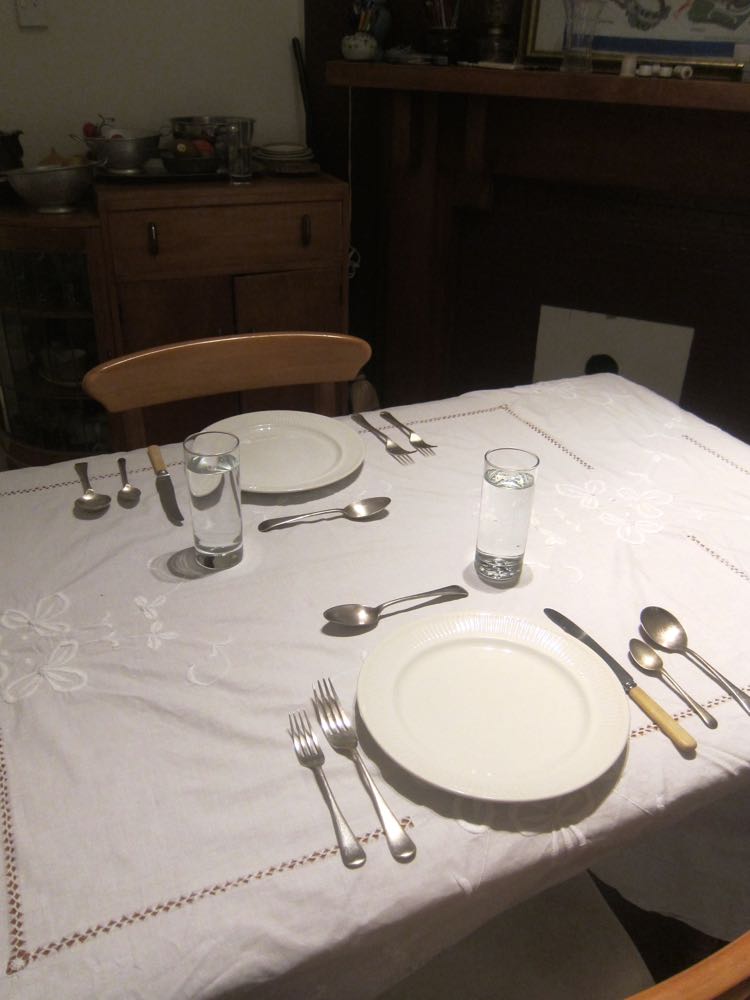
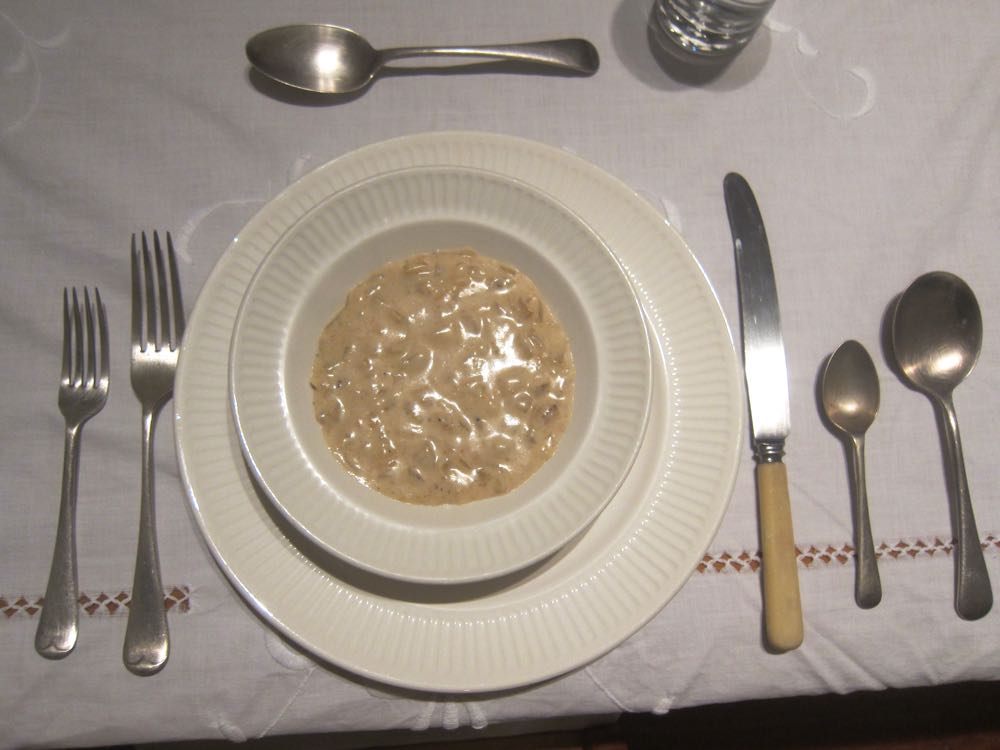
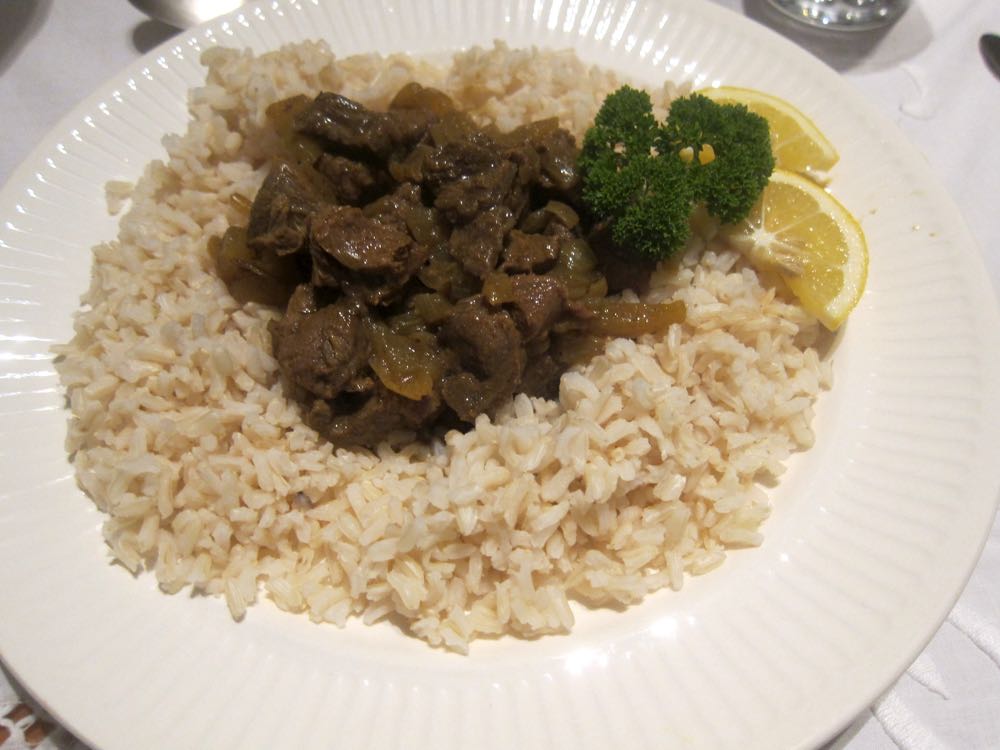
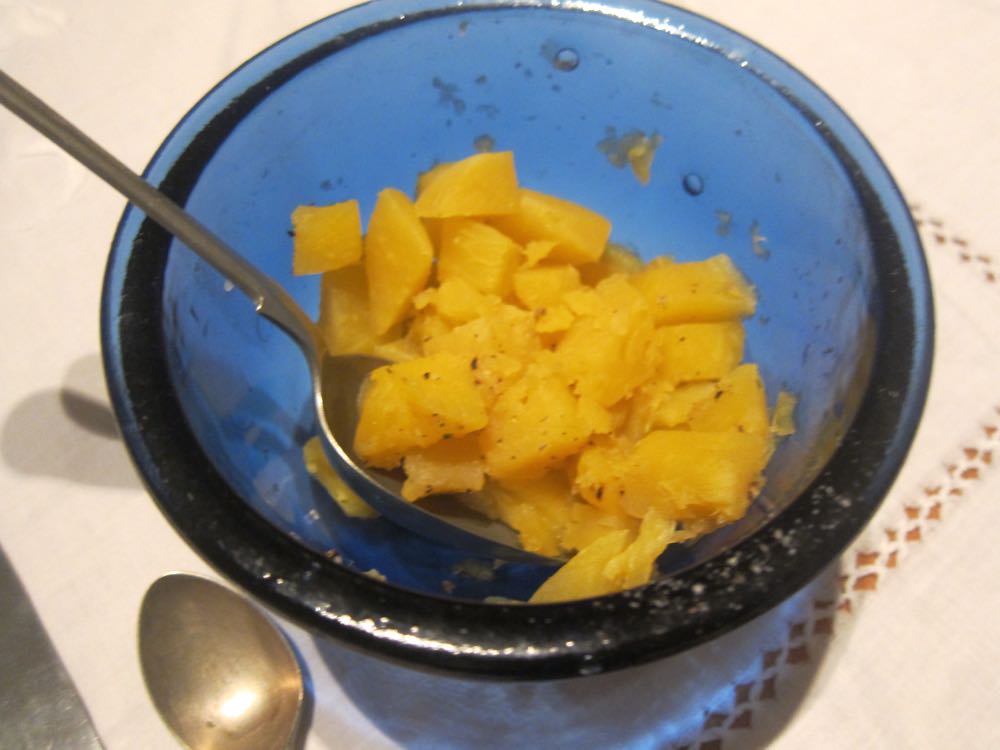
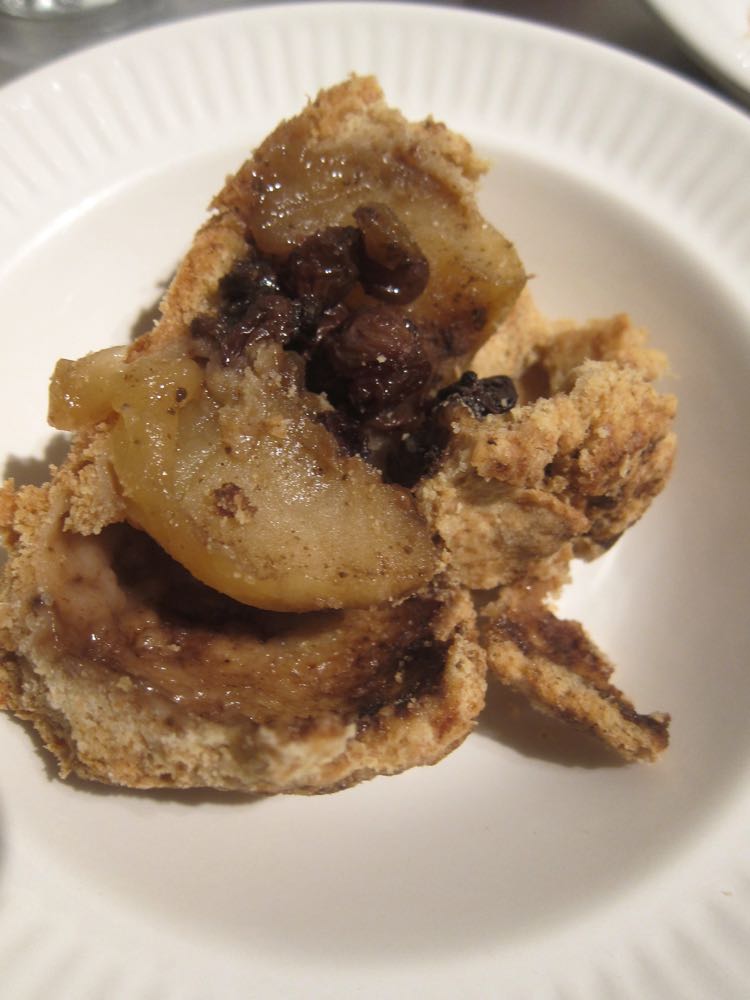
Really interesting. I was thinking about your comment yesterday about three course meals and leftover food. I would expect people, esp urban people, to have been thrifty with food, and that especially with men away at war women without a tribe of children to feed might have cooked simpler meals and reheated leftovers. But that’s all surmise, based on spurious info like the fact that though as kids in the 70s we usually had a pudding to fill the corners, my mother’s meals were much simpler than the contemporary recipes in the women’s weekly. In our house leftovers were refried or reheated in the oven or on a covered plate placed over a steaming pot.
Anyway your meal looks good. Did you survive washday ok? (My grandma had a pulley washing rack that lifted high into the kitchen ceiling near the stove. Were they around in 1916?
Sorry, that was stream if consciousness not trying to tell you how to suck eggs! (Just re read it and thought oh man, I’d better make that clear). Please don’t take any of my comments that way, I am in awe of your skills, knowledge and the research you do. You are very generous at sharing all of these on your blog. It’s like taking a really, really fun class with a cool teacher. Thank you.
Don’t worry! It doesn’t sound rude at all! And it’s exactly one of the thought processes that I had, and a line of research I followed. I’ll be talking about in more depth later. It’s just hard to decide what to cover in every post!
Not being a fan of onions, and also being a vegetarian, I’m only interested in the last two of your menu options. Of those, the apple dumplings sound scrumptious! I’d be willing to try the rutabagas, too, as I’m not sure what opinion I have about those since I don’t really eat them. Thanks for sharing!
Best,
Quinn
This all sounds pretty tasty. I like venison, and curry, and baked apple anything, and I’m fine with swedes.
Mmmmmm veggies and homemade food!
And you deserve all of the support.
The food actually does look pretty good, except I would be tempted to add more spices for flavor. I wonder if they did that too? I love the way you set the table. It looks so inviting. Glad you’re feeling a bit better about the experience.
I wonder about this, too–whether many older recipes are “bases” that a cook was expected to add flavor to. I use a lot of antique/vintage cookbooks, and few have “complete” recipes like ours with detailed measurements of spices, herbs, flavoring. Sometimes there are hints–“season to taste”–, and base recipes that then have a “complete” recipe with spices following it, or suggestions that variations can be effected with different flavor profiles. Often it’s something as vague as “Try with cherries and almond extract.” How much? Of each? What? Who knows…or perhaps they assumed the cook did.
Absolutely. And cooks varied the recipes based on what ingredients they had to hand. By 1900 they are significantly more precise though. If you look at the curry recipe, for example, it is specific in the amount of curry powder, but less so in the ‘salt and pepper to taste’ – which is exactly what I would expect from a modern, main-dish savoury recipe.
Honestly though, experimenting and substituting was how I was taught to cook, and how the modern-ish cookbooks that I use most (Joy of Cooking, Tassajara Bread Book, Moosewood) give many recipes. I haven’t found the recipes published in NZ newspapers in the 1910s to be significantly less precise, though harder for me as so many measures are given in pounds and pints!
I’m sure some cooks did add more spices, just like I assume you should always double the cinnamon quantities in any modern recipe 😉
However, based on the way older Kiwis cook, and the research of other food historians, early 20th c food in NZ was probably quite bland compared to modern tastes. We’re used to cuisines like Thai & Indian, where the spices are quite prominent, but NZ recipes of the first two decades of the 20th c use a very limited spice pallet, and are quite restrained in them. I’ve found that the local variants of other specific recipes; (Potage a la Bonne Femme, then a lettuce & cucumber soup, for example) even do away with some of the spices (chervil and tarragon) that appear in the versions of this recipe published in English cookbooks.
A lettuce and cucumber soup???
(Sorry for all of the extra posts…your blog is just a very good place to soak up the positivity when dealing with our current news’s sadness, so keep coming back!)
Yeah, sounds weird doesn’t it? But lettuce soups were very fashionable! I’m going to try one for our last 1916 dinner 😀
Being a historical interpreter and spending some of my time in the past, I’ve been watching this experiment keenly. I spend my days in various periods but I’m not sure I’d be so keen to to run my day to day life in period, so you have my admiration. Fascinating discoveries you’ve made – any chance of posting that Apple dumpling recipe. And has the 1916 have any impact on Felicity?
I can’t say I’m really enjoying running my whole life in period, but I am definitely learning things that I wouldn’t if I just did specific activities in period, so it’s been a valuable experiment!
If you click on the ‘Apple Dumpling’ heading it will take you through to a recipe – I have two linked. Basically you peel apples, stuff them with whatever sugar, dried fruit, jam, or spices you feel like (cloves are the most traditional), and cover in a short or puff pastry dough, then bake (though there are also recipes for steamed apple dumplings. I prefer a simple short dough, because I’m overworked as it is! I don’t have very precise measures, because (very historically) I’m a ‘take enough flour to make dough to cover each apple, add butter and water until it forms a stiff paste’ type of cook, rather than a precise measure cook!
It all looks good, though I’m not sure about apples in curry. Those apple dumplings look amazing though, as does the soup. In some ways I’m a little surprised at how simple the recipes are. I don’t know why that surprises me, since if you’re making three courses every day logistical considerations dictate that the recipes should be fairly straightforward.
And these are the more elaborate recipes! So many of them are essentially ‘Stick mutton in water. Boil. Serve. Tomorrow, chop veg into water from mutton for soup. Boil. Serve. Save tomorrow’s beef water for day-afters soup. Boil. Serve.’ A number of the menus mention leeks as the side vegetable, and I had to figure out how you cooked them: Boil. Serve. Surprise surprise!
Lunches are a lot of ‘mince up all of yesterdays leftovers. Add egg and bake or deep fry’ So they are rather elaborate in all the mincing and chopping.
It’s funny, because I learned while living in France that there really only needs to be a few ingredients of fresh things added together to make a dish or meal. This post seems to add to that theme: Put together a few quality ingredients, and then let them shine on their own!
Also, courses really do make sense: vegetables are quicker to cook than meat. So you cook the vegetable, and while it is cooking, make the meat. Then, eat the vegetable while the meat finishes cooking (or resting), and bring out that course. It’s a lifesaver with a two-year-old, because then the kiddo eats the veggies while hungry, then goes to the main course.
Apples in a curry (known as a “sweet curry”) are pretty traditional here in Australia especially in country areas. Cookbooks put out by local organisations still often feature apples -and sultanas- in their curry recipes. It`s actually very nice as the sweetness balances the heat from the curry. Or perhaps it`s just me………..?
That onion soup recipe looks pretty good – and a lot simpler than the recipe I’ve been using. Given the price of milk, though, I might try using stock instead.
I found it a bit rich and thick actually, and poured in a little of the water from boiling my swedes to thin it, which worked nicely.
sewcharacteristicallyyou.comAt least the food is turning out fairly well. I would have trouble continuing with an experiment like this if I didn’t like the food. I am sure that you will be processing all the things you learned from this experience for many more months.
Sarah
http://www.sewcharacteristicallyyou.com/blog
Oh I love cooking historical recipes! It is really fun reading all your accounts. Rutabagas are easy to find here in the US, but most people don’t cook except from a box/bag, and you don’t see rutabagas, even in the frozen foods. I think they are best roasted with parsnips and turnips (although I don’t really care for turnips), with some olive oil and spices. The roasting brings out the best in their flavor. You can them mash them up if you like after. For the non-veg, I like to roast a chicken over them and let the juices drip instead of olive oil.